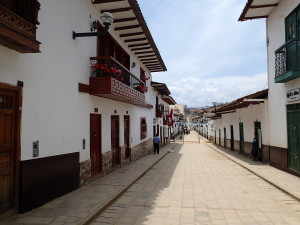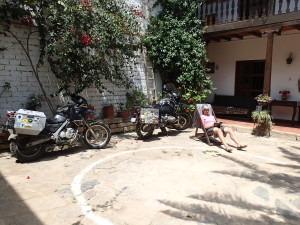We left Hippie town “Vilcabamba” on Monday and were planning on crossing the border to Peru that day, the GPS just showed 160 km – no problem. But as it turned out it was all gravel road over the mountains with beautiful views. It took us 5 hours to reach the border town of Macara on the Ecuadorian side. Since it was getting late to reach a city on the Peruvian side we decided to stay in Macara one night and then cross the border early in the morning next day. We found a fairly nice hotel with secure parking and since it was still a holiday we managed to find one open restaurant. All the other ones were closed.
Next day we crossed the border into Peru at Macara. The border crossing was not busy at all and after an hour and a half we were free to go. Vehicle insurance is mandatory but there was no insurance agent at this border crossing, so the border patrol officer demanded that we drive into the next big city (which would have been three hours away) to find an insurance office. Since that town was not on our route we decided not to bother. If a police officer is going to ask, we will play dumb and claim to have an international insurance policy.
When we crossed the bridge into Peru it was shocking to see the difference to Ecuador. The land changed to a dry, dusty landscape with lots of garbage on the side of the roads. What we call houses were not to be found, just shacks. We could not believe the change in living conditions from one country to the next. And instead of cars there were Tuk Tuk’s, lots of them.
After two hours the landscape became greener again and you could see more solid build houses again. Our goal was to get to Chachapoyas, but as we found out from locals it would have been tough to reach that day. As we were driving along there was water running over the concrete pavement of the road and beside there was a bridge to allow for an alternative. But the water was not deep and locals with cars and tuk tuks were driving through the water. People were pointing to the bridge for us to use. But I was thinking why not drive through the water. Male stupidity took over and I decided – no big deal – I will drive through the water. And – boom crash – there was a reason people pointed to the bridge. The pavement under the water was full of algae which made the surface like soapy slippery. I crashed on the left side and the crash bar was bend the third time on this journey and the left pannier was damaged and the bottom a little ripped – I had drain holes in the pannier now J. Anyway I was wet and smart Feli had stayed behind to watch the male macho stupid act. She came over to help get the bike up, but we failed every time because it was so slippery, so dropped the bike twice more. We then asked people for help and four people jumped out of their Tuk Tuk and it really took six people to get the bike to dry ground. I had a perfectly save option to travel that stretch of the road but my male ego took over – hopefully I have learned another lesson. I took the left pannier off the bike and hammered it in shape again with rocks and we were ready to go on again.
We reached a town called “Olmos” and stayed at “Hospedaje Monterrico” which offered a decent room and good covered parking, they even had a pool to cool off. The town itself was not very pretty and quite dusty and dirty.
On Wednesday we reached Chachapoyas (the capitol of the province of “Amazonas”) which is a peaceful and friendly city with many Colonial mansions and white washed houses that exhibit more than 4500 balconies. The road to Chachapoyas was spectacular with lots of twisties and great views of the mountains. Along the river we saw lots of rice fields and people were busy attending their fields. What is always astounding is that the mountain sides of the roads are almost never secured against rock slides. So often you find rocks on the road and you have to drive carefully around the corners because you never know what you will find. And there are lots of animals on the road as well: donkeys, goats, sheep, horses and cattle. In Colombia and Ecuador they were tied to the side of the roads, here in Peru nobody is bothering to do that anymore – it is a free country for animals. At one point we had to wait till a landslide was cleared from the road to reach Chachapoyas.
In Chachapoyas we found a nice place to stay right at the Main Square the “Hostal Revash” with a beautiful court yard and a really nice owner “Carlos”, who was going out of his way to make us feel at home. Chachapoyas is the heart of pre Inka culture of the same name. The Chachapoya people left extraordinary remains in this area including vast fortifications as these “Cloud Warriors” defended their independence from the Huari and later the Incas.
On Thursday we explored the town and I fixed the left pannier of my bike again with epoxy “Cold Weld” so it can survive another crash.
Friday we had booked a tour to “Kuelap”, a great pre-Inca walled city perched high above the Rio Utcubamba at 3000 metered elevation. We took a bus (two and a half Hours each way) with a guide (Augusto, who spoke 5 languages) to the site. The location and the ruins are nothing short of spectacular and it is likely the biggest site of its kind in South America, bigger than Machu Picchu.
It is not very touristy, but I believe that will change soon, a French company is building a cable car line that will make the journey to the site easier and will be finished next year.
The extensive citadel was the centre of the Chachapoyas civilization (AD 200 – 1475) and was rediscovered in 1843. The enormous complex has more than 600 metres of up to 19 metres high lime stone walls on the outside and had 335 buildings on the inside. 3000 people used to live here till it was abandoned. The city has three narrow entrances and an ingenious system for channeling rainwater. Some buildings are decorated with rhombus and zigzag shaped friezes.
After seeing the magnificent ruins we spent the next day in town again enjoying to walk the street and going to the local market which is housed in a two storey building close to the Main Square.
It is amazing to see the variety of produce, flowers, meat and other items in such a market. You step into such a market and you step into the soul of a country. Lots of indigenous people selling and buying and common people shopping for all their needs. And that is such a huge difference to markets in North America where “Farmers Markets” are upscale in price and quality and only attract people with higher incomes. Here it is the opposite, these markets are far from upscale but they are authentic true markets for the people who can not afford higher prizes in “supermarkets”. Our markets seem sterile compared to the markets in Central and South America. I mean here the markets are not clean, there are all kind of animals (dogs, cats and live chickens) running around and with all the meat vendors there is not a single fridge to be found – every health Unit in North America would go nuts over such a market, but I believe if you compare rates of allergies in the general population here and at home the difference is huge. I don’t think they even know here what an allergy is. At home we live in an environment that is too sterile.
Anyway after enjoying almost a week in Chachapoyas it will be time again to be on the road, so we are heading for Cajamarca tomorrow. We really enjoyed Chachapoyas which is a genuine Peruvian Town with not a lot of tourists and being just the opposite of towns like Vilcabamba.
Cheers, Heinz























